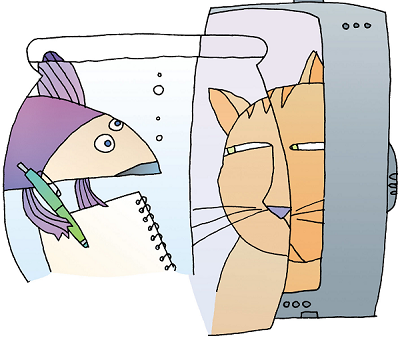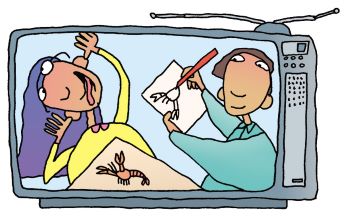Page 373
Improving Viewing Skills

If you are like most students, you spend many hours staring at screens, whether computers or TVs, smartboards or phones. Make sure you don’t just let all those images and ideas soak into your brain. Instead, you should think critically about what you view.
Someone made this content. Why? Someone is trying to make you feel something or think something. What is it? Someone wants to sell you something. . . .
This chapter will help you take charge of the viewing that you do throughout your day. Critical viewing will make you a better student and a better thinker.
What’s Ahead
WE 374
Page 374
Watching the News
1. Watch for completeness.
Whenever you watch the news, you need to make sure it’s telling the complete story. A news story must answer the 5 W’s and H about an event.
- Who was involved? . . . truck drivers
- What happened? . . . . . . . . nine trucks tipped over
- When did it happen? . . . this morning
- Where did it happen? . . . on Interstate 25 near Cheyenne, Wyoming
- Why did it happen? . . . . wind gusts of 65 mph
- How did it happen? . . . trucks with lighter loads blew over
2. Watch for correctness.
A news story should report only facts. If the reporter doesn’t know all the facts yet, the story should say something like this:
So far, we have not received reports of serious injury, but we are checking with police and local hospitals.
Tip The red words tell you that the report may not be correct. You should watch for news updates.
3. Watch for balance.
A news story should tell all sides of the story.
What facts and pictures are included? 🟪 Let’s say a city is voting whether to remove a dam and drain a lake or replace the dam and dredge the lake. How is the situation explained and shown?
Who is interviewed? 🟪 A balanced story would include interviews with government officials and community members who are in favor of removing the dam and others who are opposed to it.
WE 375
Page 375
Watching Documentaries
A documentary is a program that gives detailed information about one particular subject. Here is a plan to help you view and analyze any documentary you watch.
Before Viewing
- Think about what you already know about the subject.
- Write down questions you may have about the subject.
During Viewing
- Watch and listen for the answers to your questions.
- Write down interesting facts and any new questions you have.
- Watch for completeness, correctness, and balance. (See page 374.)
After Viewing
- Compare notes with someone who also saw the documentary.
- Write a summary of the program in your learning log.
Documentary Notes
Thursday, November 7
King Tut’s Tomb
King Tut had a huge sarcophagus (“flesh eater”) carved of quartzite.
— It held 3 coffins, nested like a Russian doll.
— Each coffin showed Tut with a crook and flail.
— He had a headdress and a long braided beard.
— Tut looked like Osiris, god of the underworld.
— The third coffin was made of solid gold.
— It held the mummy of King Tut.
The sarcophagus was inside four shrines (wooden boxes covered in gold).
WE 376
Page 376
Watching for Fun
Even when you just want to have fun, it’s important to think about what you’re watching on television or online.
Is it real or staged?
Medical, crime-fighting, and family shows may be based on real-life situations, but they often exaggerate emergencies, chase scenes, or jokes. Remember that such shows are designed just to entertain you. They are not real life.
Documentaries often re-enact important historical events, like the Lewis and Clark Expedition. Because this event took place more than 200 years ago, nothing new or modern should show up in any of the scenes. Watch and listen carefully. Try to tell the difference between what is real and what is staged.
Is it fact or opinion?
A movie star on a talk show may say, “It’s time for everyone to become a vegetarian.” Keep in mind that celebrities are not necessarily experts on nutrition and food. Their opinions are just that: opinions.

Is it showing stereotypes?
A stereotype is an unfair generalization or prejudice. It is like saying, “If one is a certain way, then all are that way.” Here are two examples of stereotypes:
Doberman Pinschers are always mean.
Boys can’t draw.
Note It’s true, some Doberman Pinschers are mean, but others are as nice as can be. And some boys can’t draw, but many boys are great artists. Watch out for stereotypes in TV shows. Make sure you don’t judge people (or anything else) by an unfair generalization or stereotype.
WE 377
Page 377
BE AWARE: Watching Commercials
Commercials have one main purpose—to get you to buy things. Here are five selling methods that commercials use to persuade you.
Slice of Life 🟪 These commercials often look like home videos. The people in them are happy because they are drinking Brand X cola or wearing Brand X shoes.
BE AWARE: The people in these commercials are actors. They’re being paid to look like they’re happy.
Famous Faces 🟪 These commercials use athletes and other famous people. If you want to be like these famous athletes, you’ll eat the same fast food they eat, right?
BE AWARE: Famous people may not really use the products they sell on TV. They are paid to be in the ads.
Just the Facts 🟪 These commercials quote facts and figures. Let’s say a commercial says, “Nine out of ten fourth graders asked for our cereal!” Where did those figures come from?
BE AWARE: The survey of fourth graders may not have been fair. The cereal company may have asked, “Which would you rather have for breakfast: peas and carrots or our cereal?” That’s a silly example, but you get the idea!
Problem-Solution 🟪 These commercials show someone with a problem. Then they show Brand X solving the problem. For example, Janet hates to do her homework. Her parents buy her a new computer with lots of software. Suddenly, Janet loves doing homework.
BE AWARE: Very few problems can be solved just by buying something.
Infomercials 🟪 These commercials look like TV shows (usually half an hour long). They give a lot of information to get you to believe their products are the best you can buy.
BE AWARE: Infomercials are just long commercials. The presenter (and the audience) have been hired to sell the product.
WE 378
Page 378
Viewing Online Sites
Like television, the Internet is a popular source of information. When you look for something online, try to answer these questions:
How does the information compare to other sources? 🟪 When you search for information on the Internet, look at more than one site, or check the information with a book or magazine. This comparison will help you check for accuracy.
Who publishes or develops the Internet site? 🟪 The publisher may be a company, a school, a person, a club, or some other group. Knowing who publishes the site can help you answer these questions:
-
Is the information from a reliable source? Imagine that you’re looking for information about tornadoes. A website published by the National Weather Service has information from experts you can trust. A website published by someone who chases tornadoes as a hobby may not be as trustworthy.
-
Is the information balanced or biased? Let’s say you’re looking for information about good eating habits. An Internet site published by a respected health magazine will most likely have balanced information. A website published by a company that produces breakfast cereal may be biased, making its products sound more healthful than they really are.